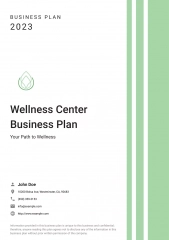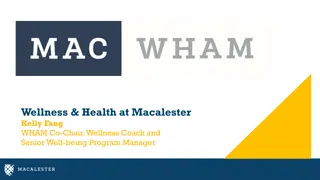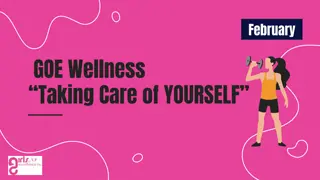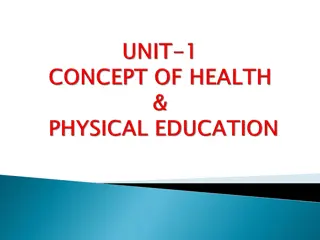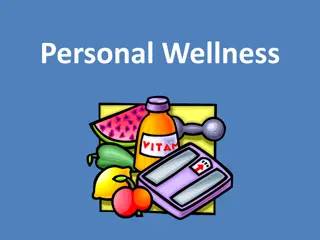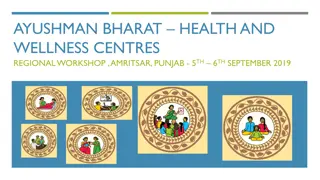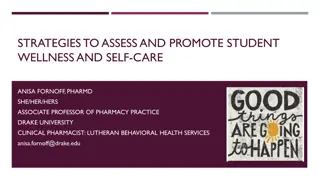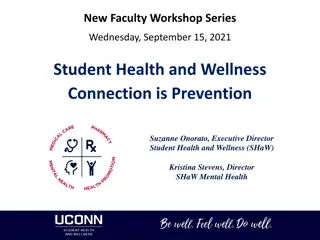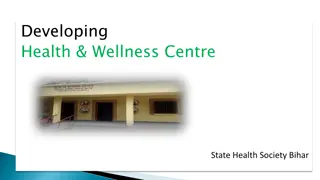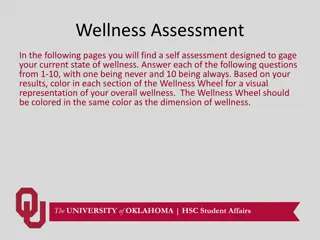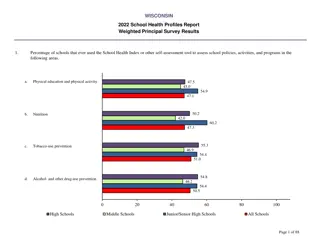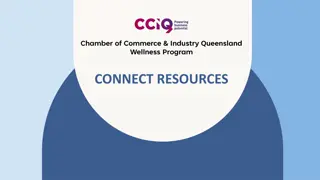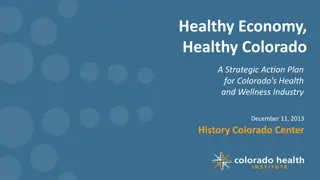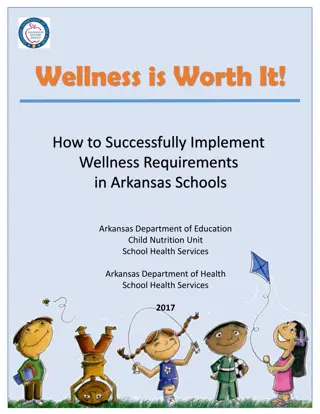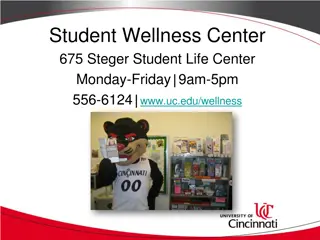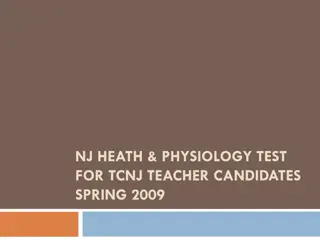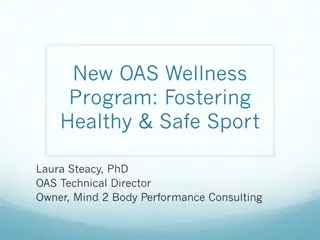Comprehensive Guide to Personal Health and Wellness
Explore the essential aspects of personal health, including maintaining overall well-being, dental and oral care, skincare, and tips for a balanced diet and fitness routine. Learn about the importance of vitamins, antioxidants, and hydration, along with practical advice for nurturing a healthy lifestyle.
Download Presentation

Please find below an Image/Link to download the presentation.
The content on the website is provided AS IS for your information and personal use only. It may not be sold, licensed, or shared on other websites without obtaining consent from the author.If you encounter any issues during the download, it is possible that the publisher has removed the file from their server.
You are allowed to download the files provided on this website for personal or commercial use, subject to the condition that they are used lawfully. All files are the property of their respective owners.
The content on the website is provided AS IS for your information and personal use only. It may not be sold, licensed, or shared on other websites without obtaining consent from the author.
E N D
Presentation Transcript
Table of Contents _ Vitamins _ Water _ Antioxidants _ Advice and Guidance 1 Personal Health Teeth Skin Feet Clothes Sweat 2 Nutrition _ Balanced Diet _ Carbohydrates _ Fat _ Fiber _ Protein _ Minerals 3 Fitness _ Muscular Endurance _ BMI _ Cardio Vascular Endurance
PERSONAL HEALTH Health is not merely the absence of disease but a state of physical, mental, social, emotional and spiritual well being. There are a few general rules to maintain good health.
General rules to maintain good health. Do Don t Eat a balanced diet Take regular exercise Develop a positive attitude in life Smoke Drink alcohol Misuse drugs
PERSONAL HEALTH Taking care of the body parts like Teeth, Skin, Feet, Clothes, Sweat and their related aspects is essential for maintaining GOOD health.{
TEETH ORAL OR DENTAL HEALTH They are precious gift of ALLAH for chewing food and ingestion of food onwards to thedigestive system. There are 32 teeth in an adult. They require regular attention and if neglected lead to lossof teeth. Decay of teeth is the most common disease caused by cavities. Cavities are formed due to bacteria on the tooth surface which dissolve calcium salts of the teeth and reduces the distance between outside of the teeth and nerveendings ultimatelycausing toothache. Sugary foods and neglect of oral hygiene lead to toothache, gum diseasesand lossof teeth.}
TEETH ORAL OR DENTAL HEALTH PRECAUTIONS Brush the teeth twice a day using a medium tooth brush with soft bristled brush. Spend at least 3 to 5 minutesof yourprecious time for brushing. Change thetooth brushonce in 90 days. Use the correct technique to brush the front and back side of the teeth. Use a toothpaste that contains fluoride which prevents cavities and toothdecay. Do not use abrasive tooth powder, salts, tobacco for cleaning teeth. Tartar, which settles on teeth, is a plague in the hardened form which is damaging and difficult to remove, hence use anti tartar pasteand mouthwash.}
TEETH ORAL OR DENTAL HEALTH PRECAUTIONS : Use dental floss for removing food particles struck in the teeth and avoid the useof pins, tooth pricksetc. Do not smoke, do not use tobacco, chew gum, chocolates, candyetc. Rinse the mouth aftereating sugaryand starchy foods. In case of irregular, sharp, broken teeth contact the dentist immediately. Do notapply medicine withoutconsulting yourdoctor. In case of tooth ache, gum bleeding, ulcers of the gum, cheek, white patches, etc, consultyourdoctor. Eat plenty of crunchy vegetables and fruits. Have regular check upevery 6 months.{
SKIN Skin is the outer most covering of the body, is also called as epidermis and the largestorgan of the body. The skin contains thousands of cells, hundreds of sweat glands, oil glands, nerveendings and blood vessels. It protects our bones, muscles, nerves, blood vessels and prevents harmful substances and micro organisms from entering the body. It protects the tissueagainst injury. Itcontrols the lossof fluids like blood and water. It helps in the regulation of body temperature through perspiration. It protects againstsunsdamaging ultraviolet rays. Thecells of the skin are replaced completely every 28 days. }
SKIN PRECAUTIONS : Skin should be washed with soap and water to keep it clean. Bath once or twice every day persons involved in physical activityshould takea bath aftereveryactivity. Dry the skin with a clean towel, avoid sharing of towel and soaps. Over exposure to sun is harmful as it causes sun burns, hence use sun screen lotion for every 2 to 3 hours. Protecteyesand facewith sunglass and hat. Avoid getting tenderpimples in lips, use medication.}
SKIN PRECAUTIONS : Usecold creamduring winters. If the skin gets itchy, dry and red with rashes smoothen itwith moisturizers. Warts are skin infections caused by virus hence do not prick, rub, or scratch as it will spread. Use medication forsuchcomplications. Bug bites and bee stings are very poisonous, they should not be scratched and the use of ointments is advisable. Takecareof burns. Eating well and exercising will help one maintain a good and healthyskin.{
FEET Feet perform the duty of carrying the body weight and also helps in the locomotion of the body. It is said that one who has a better foot arch has more agility as the body weight is evenly distributed than a person who has flat feet. Feet has 26 bones and 33 joints. Some of the problems of feet are inherited and some are due to wear and tear.}
FEET The signs of foot trouble are: 1. Pain 2. Excessive dry skin 3. Thickened or discolored nails 4. Swelling 5 Redness and unusual sensation. These symptoms are due to : 1. Problems of legs, hips and back 2. Due to mineral and vitamin deficiency 3. Iron deficiency and tight fitting shoes 4.Kidney disease, heart trouble and hypertension 5.Diabetes{
FEET HYGIENE There are 250,000 sweat glands in the foot. They produce a mixture of sweat, bacteria in shoes and socks which smells. Clean feet reduces smell and fungus. Wash feet with soap and lukewarm water as it removes dead skin, fungus and bacteria. Clean between toes where more bacteria get collected than anywhere else. Dry with a soft towel. If the towel is not reaching between toes use dry face wash. Cut nails properly and at regular intervals.}
FEET HYGIENE In swimming pool and public showers wear thongs as you may easily pick up fungal infections, warts etc. Take care of corns and blisters with a right size shoe. Shoes are to be washed every 15 to 20 days. Running shoe to be discarded after 200 to 400 miles of use. Use shoes meant for the particular activity like football boot not to be used for walking, basketball etc. Avoid using hard surface and use sponge in the heel region to avoid heel spur.{
CLOTHES Human body needs to be covered with clothes to protect from external environment and ensure a constant temperaturecontrol. This apart clothes enhances the personality of an individual. Wear looseclothesand avoid skin tightclothes. Cotton clothesarepreferable. Clothes can get stained, dirty and grubby, so change them often. Change wet clothes immediately as the bacteria works fasterundertheseconditions.}
CLOTHES After conclusion of exercise change the clothes immediately and wearfresh clothes. Wear under garments and wash them regularly since being right nextto theskin theycollectdead cells, sweatand otherstains. Stay away from cigarette smoke as the smell will get into your clothes, hairand make themsmelly. If you wear the same clothes next day, hang it up in air / sun beforeyouwearit nextday. Change thesockseverydayoreverysession. Wash the socks in warm water and if needed add anti septic liquid. Socks should have loose fitting as tight socks stop blood circulation.{
SWEAT Sweating isalsocalled as perspiration. It is the production of watery fluid which contains dissolved solidsof Chlorides by thesweatglands. Sweating is primarily a means of thermoregulation as it has a cooling effect to counteract the heat of the environment, the heat produced by the muscles due nervousness. Skin containsthousands of sweat glands which are present inthe subcutaneoustissue. Theglandsareof two types: 1.Accrine glands; they are found in the forehead, palms and soles of the foot. 2. Apocrine glands; they are developed at puberty in armpits and pubic region. The sweat at the later is thicker and when it mixes with bacteria, causes bodyodor.} to exertion, nausea and
SWEAT Sweat is nothing but dirt, dead cells and bacteria containing salt, water and some organic material as well as enzymes which have the ability to break down certain type of bacteria that liveon the skinsurface. Healthy adult secretes around half literto one literof sweat daily and during physical activity, fever or hot environment it is increased drastically. Sweat helps the body to release harmful toxins, salts and protects skin from dehydration. Sweating occurs under two situations the first one when the nerves stimulate the glands making us sweat during physical heat which occurs through the body, while in the second it is emotional stress which includes sweating in the palms, soles and sometimes forehead.}
SWEAT Excessive sweating occurs due to hereditary reasons or becauseof the consumption of some foodsand drinks. Some diseases and conditions can produce profuse sweat like heart attack, malarial fever, other fevers, thyroid conditions, tuberculosis and low blood sugar. Sweat has to be cleaned with soap and water especially in the armpits and pubic region. Always use a towel while practicing in the gym as the sweat on the surfaceof the equipment maycause infection. Always change the clothes of the sweat immediately after exercise. Drink plenty of fluids, waterand juices. Bathe frequently withcold water.{
NUTRITION It is the study of nutrients and the processes by which organisms utilize them, the way our bodies take in and use food. Nutrients give us energy, growth and helps to repair body tissues. They regulate the body function. There are six different types of nutrients. Carbohydrate , Protein , Fat, Water, Vitamins and Minerals . Each nutrient is vital for the health. Carbohydrates, Proteins and Fats are termed as Macro nutrients, while Vitamins, minerals and water are called as micro nutrients.
Calories : The energy we use is called calorie. A calorie by definition is a measure of energy content available to the body in one or more foods. The more calories we eat, the more energy we have. Maximum calorie intake should not exceed ones current weight in kilograms x 24. To loose weight ,do an hour s walking daily and reduce the calorie intake between 1000 to 1500 daily. Do not go below 1000 calories at any time. For Loosing or gaining body weight add or subtract 500 calories daily.
Calories : Caloric Value of Nutrition: 1 gram of carbohydrates supplies the body with 4 calories. 1 gram of protein supplies the body with 4 calories. 1 gram of fat supplies the body with 9 calories. Vitamins, minerals, and water provides no calories.
Balanced Diet: A diet that provides all the essential nutrients in sufficient quantities and in the correct proportions to promote health is called as Balanced Diet. Balance diet should not contain items that are harmful to ones health. A balanced diet contains all the six types of Nutrients.
Carbohydrates: Carbohydrates are composed of carbon and hydrogen atoms. They provides ENERGY to the structure of cells and allow for a proper metabolic balance. Carbohydrates are the chief source of energy which fuels the brain. There are two types of carbohydrates: simple carbohydrates such as ( sugar & honey ). complex carbohydrates (such as grains, beans, peas & potatoes). Complex carbohydrates are preferred because these foods are more nutritious and have fewer calories per gram compared to fat . Complex carbohydrates are also preferred over Simple carbohydrates by diabetic patients because they allow better blood glucose control.
Carbohydrates: . The Sources of carbohydrates are: Complex Bread Fruits Rice Vegetables Pasta Potatoes Cereals Whole grains Simple
Protein : Protein consists of amino acids which build and maintain healthy body tissue. There are 20 amino acids considered essential because the body must have all of them in the right amounts to function properly. 12 aminoacids are manufactured by the body 8 amino acids has to be taken from the diet sources such as milk oreggsand variety of plant products. Protein is needed for building ,maintaining and repairing of muscles, red blood cells, skin, hair, and other tissues. Sourcesof protein Eggs, Milk, Chicken, Fish ,Soya beans .
Fat: Fats are made up of the same elements as carbohydrates carbon , hydrogen and oxygen but the way atoms are linked together is different . Fats can be found in both plants and animals and are insoluble in water. Fats in the body serve three basic functions: 1) provide the major source of stored energy. 2) serve to cushion and protect the major organs. 3) Act as insulators, preserving body heat and protecting against excessive cold. Fat has the highest calorie among all the nutrients. A pound of fat contains about 3500 calories, as opposed to 1600 calories stored in a pound of protein or carbohydrate .
Fat: Sources of Fat : Saturated fats are found in food such as; Beef lamb ,Chicken ,Shell fish ,Egg yolks ,Cream ,Butter ,Chocolate . Un saturated fats are found in foods such as : Avocadoes ,Cashews ,Olives & olive oil ,Peanuts, peanuts oil, and peanuts . Poly saturated fats are found in foods such as : Almonds ,Cotton seed oil ,Sun flower, Corn oil ,Cord liver oil ( fish oil ) ,Soya bean oil .
Vitamins : Vitamins are organic substances present in food. They do not provide anyenergy. Vitamins are required by the body in a minute amount for regulation and maintenanceof normal growthand its functioning. Thereare two types of vitamins, they arewatersoluble and fat soluble. Fat soluble ( absorbed in the body) A,K,D and E Sources Vitamin-A found in carrots (forvision) Vitamin K found in cheese, coffee, green tea, leafy vegetables (blood clotting, bone formation) Vitamin D found in milk, onions and sunlight mobilization) Vitamin E found in green leafyvegetables (antioxidants, fertility, and arteries) ( calcium absorption &
Vitamins : Water soluble : (act as catalyst in the body) B1-Thiamin converts carbohydrates to glucose (found in whole grains, legumes, poultry and fish) B2-Riboflovin helps tissues, nerves, and vision (found in leafy greens) B12- for metabolism Vitamin-C for resistance power, helps to loose fat, & reduces ageing process (the best sources are lime, oranges, guava fruit, grapes, jack fruit, and mangoes). VITAMIN-C ARE NATURAL FAT BURNERS .
Minerals : Minerals are vital to our existence because they are the building blocks that make up muscles, tissues, and bones. Minerals are also important components of many life supporting systems, such as hormones, oxygen transport, and enzyme system. Thereare two kinds of minerals : The Major minerals are the minerals that the body needs in large amount, and they are; Calcium ,Phosphorus ,Magnesium ,Sodium ,Potassium ,Sulfur and Chloride. They are needed to build muscles, blood , nerve cells, teeth, and bones. Trace minerals are needed in tiny amounts. Trace minerals participate in most chemical reactions in the body and they arealso needed to manufacture important hormones. Trace minerals are; iron, zinc, iodine, copper, manganese, fluoride, chromium, selenium, molybdenum, and boron.
Water : Water is the most important replacement fluid. Makes up 50-70% of body weight . It stabilizes body temperature, carries nutrients to cells and takes out waste from cells . Waterdoes not provideenergy . It is advisable todrink water before, during & afterexercise. The normal intake of water should be a minimum of 8 glasses in aday. The most popular and the best water is ZAM ZAM , which has all the minerals present in it.
Food Ratios: Food should be taken in the following ratios: Grain & cereal -40% , Vegetable & fruit -35% , Dairy products - 10% , Meals -10% Other foods - 5%.
Malnutrition : It is a condition that develops when the body does not get the right amount of the vitamins, minerals, and other nutrients needed to maintain healthy tissues and functionsof the organs . Malnutrition occurs in undernourished orover nourished. people who are either Under nutrition is a consequence of consuming too few essential nutrients or using or excreting them more rapidly than they can be replaced.
Advice and Suggestions : Do Prefer quality of food than quantity Take a balanced diet Take small meals in a day ,preferably 6 meals with a gap of 2 to 3 hrs Take plenty of green vegetables at least 4 times a day Take fruits at least 4 times a day Take at least 8 glasses of water in a day Prefer foods with low calorie Take a maximum of 2 tea spoons of sugar in a day Take white meats, chicken without skin & fish not more than 90 grams per serve Take fruits rich in vitamin C after the meals Take fresh fruit juices every day
Advice and Suggestions : Do not : Add table salt to your food Take fatty foods , junk foods , oily foods, fried foods and red meats Take preserved foods as they cause cancer Over eat specially at night Take supper Take dinner after 7pm Consume calories more than your output Take less than 1000 calories a day Combine 5 to 6 vegetables or fruits together
Please Note : Break fast like a king ,Lunch like a middle man , Dinner like a poor man . Health Corner IF YOU DON T GET TIME FOR FITNESS, YOU WILL GET TIME FOR ILLNESS. IF WELLNESS IS COSTLY, TRY ILLNESS PREFER QUALITY OF FOOD, NOT QUANTITY AVOID FATTY FOODS & PRESERVE FOODS TAKE 6 SMALL MEALS IN A DAY TAKE PLENTY OF FRUITS & VEGETABLES.
Fitness and Body Composition Physical Fitness : It is defined as the ability of an individual to carry on daily tasks with vigor and alertness without getting undue fatigue and still have ample energy to enjoy leisure time pursuits and to meet unforeseen emergencies. There are 5 Health related components and 6 Skill related components . Health related components : Body Composition : The percentage of muscle, fat, bone, and other tissues of which the body is composed is the body composition. Cardiovascular Fitness : The ability of the heart, blood vessels, blood, and respiratory system to supply fuel, mainly oxygen, to the muscles and the muscles ability to utilize the fuel for activity. Flexibility : The elasticity of a muscle comprises a person s flexibility. A fit person can move a joint through its entire range of motion. Muscular Endurance : This is the body s ability to repeatedly exert muscles for a long period without fatigue. Strength : A person can exert forces such as lifting or controlling one s own body weight.
Fitness and Body Composition Skill Related Components Agility : The ability to change directions of the body quickly and accurately is agility. Balance : Balance is the body s ability to maintain equilibrium while stationary or while moving Coordination : Coordination is the body s ability to sense with the body parts and eyes to coordinate and perform motor tasks smoothly and accurately. Power : The ability to transfer energy into force quickly is power. Reaction Time : The time elapsed between stimulation and the beginning of reaction to that stimulation is reaction time. Speed : The ability to perform a movement in a short period of time.
Body Composition It is the ratio of lean body mass (structural and functional elements of cells, body water, muscles, bone , heart, liver, kidney etc) to body fat ( essential and stored ) mass. Essential fat is necessary for normal physiological functions (ex . nerve conduction ). Stored fat constitutes the body s fat reserve that people try to lose. Body composition is used to describe the percentage of fat, bone and muscle in human bodies. The percentage of fat (body fat %) for us of most interest because it can be very helpful in judging health in addition to body weight.
Body Composition The muscle tissue takes up less space in our body than fat tissue, our body composition as well as our weight determines how lean we appear. Two people at the same height and weight may look completely different form each other because they have a different body composition . When body composition is assessed it is typically expressed as a percentage of fat in the body . So if a person has 20% of body fat , 20% of his body weight is fat mass and the remaining 80% of his body weight is fat free or lean body mass. A high percentage of body fat is associated with an increased risk of heart diseases , diabetes and other conditions. Whereas too low percentage is also associated with health problems such as malnutrition and osteoporosis. Maintaining percentage of body fat can help determine whether a person is at a healthy weight, overweight or obese.
BMI : It is a key index for relating body weight to height. It is determined when the weight in kilograms is divide by height in centimeters squared. There are numerous gadgets which have flooded the market for measuring the BMI ,but their accuracy has to be ascertained in the knowing the precise body mass index.
BMI Category Waist less than or equal to 40 in. (men) or 35 in. (women)
the risk of associated disease according to BMI and waist size Waist greater than 40 in. (men) or 35 in. (women) Waist less than or equal to 40 in. (men) or 35 in. (women) Category BMI N/A N/A Underweight 18.5 or less N/A N/A Normal 18.5 - 24.9 High Risk Increased Risk Overweight 25.0 - 29.9 Very High Risk High Risk Obese 30.0 - 34.9 Very High Risk Very High Risk Obese 35.0 - 39.9 Extremely High Risk Extremely High Risk Extremely Obese 40 or greater


